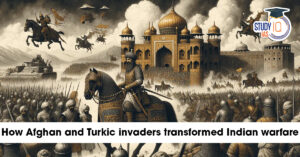Table of Contents
Vellore Mutiny
The Indian Rebellion of 1857 was preceded by the Vellore Mutiny on July 10, 1806, which was the first instance of a sizable and severe mutiny by Indian sepoys against the East India Company. In order to get ready for the UPSC IAS Prelims and Mains test, candidates might read additional NCERT Notes on the History of Modern India.
200 British soldiers were murdered during the one-day-long Vellore Mutiny, which saw mutineers seize the fort and take control of the city. Arcot’s military forces and artillery suppressed the mutiny. There were about 350 mutineers who died in total.
Read about: Revolt of 1857
What is Mutiny?
A mutiny is a revolt by a group of people, or against a previously faithful organization. The phrase is frequently used to refer to a mutiny among military personnel against an internal force, but it can occasionally refer to any kind of insurrection against any force.
Read More: Battle of Buxar
Vellore Mutiny Causes
The Hindu and Muslim Indian soldiers’ religious sensibilities were disregarded by the English. The Madras Army’s commander-in-chief, Sir John Craddock, had given instructions forbidding men from sporting religious symbols on their foreheads as well as ordering them to trim their moustaches and remove their beards. Both Hindu and Muslim soldiers were angered by this.
In addition, they were instructed to don the new round hats rather than their customary headwear. The sepoys began to worry that they were being converted to Christianity as a result of this. Craddock disregarded the military board’s advice not to change the military uniform without taking all necessary safeguards to protect Indian sensibilities.
Several sepoys who had objected to the new orders were hauled to Fort St. George and given harsh punishments. They received a hard flogging. The wife and kids of Tipu Sultan, who perished in the Battle of Seringapatam in 1799, were also residing at the Vellore Fort and were given residence in a palace there. The insurrection was also started by Tipu Sultan’s sons.
Read More: Battle of Plassey
Vellore Mutiny Course of Events
The 69th command’s 115 Englishmen and 14 British officers were slain by sepoys on July 10, 1806. At midnight, the mutiny began, and by daylight, they had taken control of the fort. On top of the fort, they hoisted the Mysore Sultanate flag.
They also crowned Fateh Hyder, the son of Tipu Sultan, as ruler of the fort. The British garrison stationed at Arcot was informed by a British officer who managed to flee the fort. British troops were led by Sir Rollo Gillespie from Arcot to their destination. He was successful in quelling the uprising.
They were expelled from the palace where they had sought safety along with about 100 Indian soldiers. Then they were told to stand in front of a wall while being shot to death. 350 Indian soldiers were killed and 350 were injured overall.
Read More: Permanent Settlement 1793
Vellore Mutiny Outcomes
The Vellore Mutiny’s three Madras troops were all dispersed. Sepoys who participated in the mutiny were brutally punished by death and prison transportation after a trial. The senior British officers in charge of the new clothing regulations, including John Craddock, were called back to their home country.
The revised clothing codes were abandoned. Whipping was prohibited for Indian soldiers. The family of Tipu Sultan relocated to Calcutta. The harsh Vellore Mutiny crackdown is thought to have contributed to the southern sepoys’ decision to abstain from the 1857 Indian Revolt.
Read More: Mahalwari System
Vellore Mutiny Significance
Even though the revolt was crushed by the following morning, it gave the British overlords cause for concern. One of the earliest indications that the British were losing their empire was this revolt. The mutiny and the Revolt of 1857 can be contrasted.
When Lord Minto arrived in India as the Governor-General in 1807, the empire was created soon after the Vellore Mutiny. Lady Fancourt (the wife of St. John Fancourt) and the fort’s commander, Amelia Farrer, were the only remaining eyewitnesses to the genuine horror of the mutiny. Two weeks after the rebellion, she wrote manuscripts outlining how she and her kids managed to survive despite losing her husband.
Read More: Ryotwari System


 Birsa Munda Birth Anniversary 2025: Life...
Birsa Munda Birth Anniversary 2025: Life...
 Military Innovations of Afghans and Turk...
Military Innovations of Afghans and Turk...
 Self-Respect Movement, History, Objectiv...
Self-Respect Movement, History, Objectiv...

























